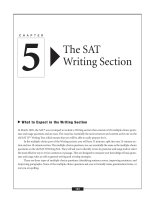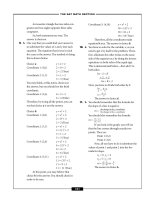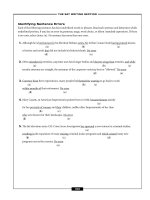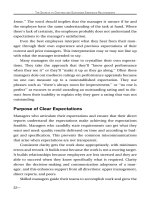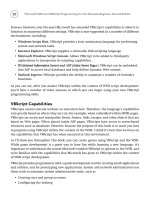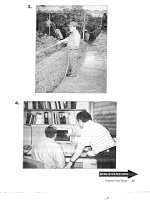The sat math section 5 ppsx
Bạn đang xem bản rút gọn của tài liệu. Xem và tải ngay bản đầy đủ của tài liệu tại đây (95.17 KB, 6 trang )
12. a. This problem is difficult if you make it diffi-
cult, but it’s easy if you make it easy. The eas-
iest way to do this problem is to calculate the
mean, median, and mode for the data set.
Remember:
■
The mean is the same as the average.
■
The median is the middle number of
data. First, you must order the num-
bers from least to greatest.
■
The mode is the most frequently
occurring number.
So, the mean equals:
ᎏ
5+7+6
5
+5+7
ᎏ
= 6
The median, if found by rearranging
the numbers in the data set as shown, is {5, 5,
6, 7, 7}. Therefore, the median is 6.
The mode is the most frequently occur-
ring number. In this data set, there are two
numbers that appear most frequently: {5, 7}.
Now, inspect the answers.
You will quickly see that choice a is cor-
rect: The mean = median, because 6 = 6.
13. c. You have to figure out if XY
and YZ
are per-
pendicular. The key thing to remember here is
that perpendicular lines intersect to form right
angles. If you can find a right angle at the
point that XY
and YZ
intersect, then you know
that the two segments are perpendicular.
In Figure 1, if XY
and YZ
are perpendi-
cular, then ΔXYZ is a right triangle because it
contains a right angle at Y.
In ΔXYZ, you are given three sides. If
ΔXYZ is a right triangle, then the Pythago-
rean theorem should hold true for these
three sides.
(Leg 1)
2
+ (Leg 2)
2
= (Hypotenuse)
2
(6)
2
+ (8)
2
= (10)
2
Note: 10 is the hypotenuse because it is
across from the largest angle of the triangle.
36 + 64 = 100
100 = 100
ΔXYZ is a right triangle and, likewise,
X
ෆ
Y
ෆ
is perpendicular to YZ
because the
Pythagorean theorem is true for Figure 1.
In Figure 2, you are given the two
angles of ΔXYZ. If a third angle measures
90°, then ∠Y is a right triangle. Thus, X
ෆ
Y
ෆ
is
perpendicular to Y
ෆ
Z
ෆ
.
m∠X + m∠Y + m∠Z = 180°, since
the sum of the angles of a triangle = 180.
25° + x + 65° = 180°
90° + x = 180°
Therefore, x = 90°. ∠Y is a right angle
and X
ෆ
Y
ෆ
is perpendicular to Y
ෆ
Z
ෆ
.
Thus, X
ෆ
Y
ෆ
is perpendicular to Y
ෆ
Z
ෆ
in
both figures. The answer is choice c.
14. d. The first thing that you should realize is that
x and y are both greater than 0, but less than
1. So, x and y are going to be between 0 and 1
on the number line.
Next, you see the formula for d; d = x – y.
To solve for d, you must substitute a
value in for x and y. However, you do not have
a value. You should recognize however that x
is less than y. Thus, whatever value you choose
for x, the answer for d is going to be negative.
Therefore, the answer is choice d.
15. a. This question involves calculating distance.
The pieces of information that you are given
or have to calculate are rate of speed and time.
The formula for distance (with these
specific given pieces of information) is:
Distance = Rate × Time
The first step is to calculate the rate
traveled at by the car.
Solving for rate, you have
Rate =
ᎏ
D
T
is
i
t
m
an
e
ce
ᎏ
=
ᎏ
1
2
10
ho
m
u
i
r
le
s
s
ᎏ
= 55 mph
Now, all you have to do is substitute
into the formula above using the rate you
just solved for.
–THE SAT MATH SECTION–
162
5658 SAT2006[04](fin).qx 11/21/05 6:44 PM Page 162
Distance = Rate × Time = (
ᎏ
55
h
m
ou
il
r
es
ᎏ
) × (h
hours) = 55h
The answer is choice a.
If you solve the formula above incor-
rectly, the other choices might seem to be
correct. Therefore, double-check that you are
using the correct formula and you are solv-
ing exactly what the question is asking for.
16. b. Inequalities can be solved just like equations.
The difference between equations and
inequalities is that equations have an equal
sign and inequalities have a greater than (>)
or less than (<) sign where the equal sign
would be in an equation. The first part of this
problem, then, is to figure out what type of
number the answer is going to be. The prob-
lem states that the solution set is the set of
positive integers. Therefore, the answers will
come from the set of numbers that include
{1,2,3,4,5,6, }.Now,look at the answer
choices. You notice that 0 is included in
choices e and c. Zero is not a positive integer;
therefore, you can eliminate those choices.
The answer must be either choice b or d.
Now, you must solve the equation in
order to figure out the answer.
2x – 3 < 5
+ 3 +
3
ᎏ
2
2
x
ᎏ
<
ᎏ
8
2
ᎏ
Thus, x < 4.
The only positive integers that satisfy
this statement are {1, 2, 3}. 4 is not less than 4.
The answer is choice b.
17. c. You should remember the form of a rational
number. A rational number is any number
that can be expressed as
ᎏ
p
q
ᎏ
where p and q are
integers and q ≠ 0.
You should recognize that π is an
irrational number. It is a nonterminating,
nonrepeating decimal. Choices b and e are
incorrect.
Choice a is ͙8
ෆ
. This can be simplified
to 2͙2
ෆ
.The ͙2
ෆ
is an irrational number. It
is nonterminating and nonrepeating. There-
fore, ͙8
ෆ
is not rational. The same reasoning
informs you that choice d cannot be rational;
6͙2
ෆ
contains the number, ͙2
ෆ
. It is irra-
tional. Choice c is 5͙9
ෆ
and ͙9
ෆ
= 3. There-
fore, 5͙9
ෆ
= 5 × 3 = 15.
15 can be written as
ᎏ
1
1
5
ᎏ
. Thus, it is a
rational number.
The answer is choice c.
18. a. You should remember that the word quotient
means the answer to a division problem. In
this problem, you are dividing a polynomial
by a monomial. Once you have realized all of
this, you can divide each individual term in
the numerator by the monomial in the
denominator. Remember, you can only do
this when there is a monomial, or single
term, in the denominator.
First, separate the fraction above into
three separate fractions.
ᎏ
6
3
x
x
2
ᎏ
+
ᎏ
9
3
x
x
2
ᎏ
+
ᎏ
3
3
x
x
ᎏ
Next, you have to divide each mono-
mial. This is accomplished by dividing the
coefficients first. It is important to remember
that sometimes you may have to simply
reduce the fraction instead of dividing.
After dividing the coefficients, you
must divide the base part of the monomials.
Remember: The way to divide terms
with similar bases is to simply subtract the
exponents. However, be careful! If you do
not see an exponent, remember, that the
exponent is implied to be 1. You should see
the rules that were explained above in the
following example.
–THE SAT MATH SECTION–
163
5658 SAT2006[04](fin).qx 11/21/05 6:44 PM Page 163
Example:
ᎏ
6
3
x
x
3
1
ᎏ
= 2x
2
(6 ÷ 3 = 2 AND x
3 – 1
= x
2
)
You should see that by following these
rules, the answer to
ᎏ
9
3
x
x
2
ᎏ
= 3x.
Now, what is
ᎏ
3
3
x
x
ᎏ
?
Easy, what is anything divided by itself?
The answer is 1. However, if you aren’t
careful, you may simply cancel out these last
terms. You cannot do this because you are
dividing.
The answer is choice a. If you haven’t
realized this yet, choice b looks like the answer
if you made a mental error and crossed out
the 3x term. Don’t make this mistake!
19. c. First, you have to remember the formula for
the volume of a rectangular prism.
The formula is:
Volume = length × width × height
V = l × w × h
Now, you have to interpret and write, in
algebraic terms, what is happening to the
dimensions of the prism. This is best
achieved by using a key or legend.
KEY:
Let 2 × l = the length is doubled.
Let 3 × w = the width is tripled.
Let h = the height remains the same.
Next, interpret the new volume based
on the new dimensions.
New Volume = (2l) × (3w) × (h)
= 6(l × w × h)
You should see that the original volume
was equal to l × w × h. The new volume, 6(l ×
w × h) is six times the original volume.
Therefore, the answer is choice c.
Trying the formula for volume with sim-
ple numbers inserted into it, like 1, then recalcu-
lating the new volume using the changes
mentioned in the problem may be an easy
alternative. For example,
V = l × w× h
. Setting all
three quantities equal to one yields a volume of
1 (one times one times one is one). Now if you
double the length, the length is now two and
tripling the width makes it three. Using the
equation again with these new quantities gives:
V
= 2
×
3
×
1 = 6, the answer to the question.
20. a. This problem requires you to read carefully
and determine what is actually given and what
you are really trying to solve. You are told that
the association is charged the following:
Given:
$20 charge for rental of the dining room.
$2.50 charge for each dinner plate.
Also, the association invited four non-
paying guests and they must have enough
money to pay the entire bill to the hotel.
Four nonpaying guests cost the associa-
tion $10 because 4 × $2.50 = $10.
The association incurs the following
costs: $30 + $2.50 × (# of paying people
attending).
The $30 comes from the $20 charge for
the dining room and $10 fee for inviting the
four nonpaying guests.
The association charges: $3.00 × (# of
paying people attending).
So, if the association must have enough
money to pay the hotel, what the association
charges must be equal to what the hotel
charges the association.
Amount the association is charged =
Amount the association charges guests
$30 + $2.50 (# of paying people) = $3.00
(# of paying people)
Let x = # of paying people.
Thus:
$30 + $2.50 x = $3.00x
$30 = $.50x
60 = x
Therefore, 60 guests must attend. The
answer is choice a.
–THE SAT MATH SECTION–
164
5658 SAT2006[04](fin).qx 11/21/05 6:44 PM Page 164
21. c. If you want to find the roots of an equation
algebraically, you have to factor the equation
and solve for the variable term.
So, looking at the trinomial 2x
2
– x –15, you
should notice the following:
(1) There are no common factors
between the three terms.
(2) There are three terms. This elimi-
nates the technique of factoring by
difference of two perfect squares.
(3) You can always use the quadratic
formula to find the roots. This is
sometimes difficult, especially if
you do not remember the formula.
Let’s try factoring into two binomials.
After trial and error, you will see that
the expression can be factored into
(2x + 5)(x – 3) = 0.
Now, you are multiplying two binomi-
als together and the product is equal to zero.
Thus, one of the binomial terms, if not both,
equals zero.
So, let’s set each term equal to zero and
solve for x.
2x + 5 = 0 x – 3 = 0
– 5
– 5 + 3 + 3
ᎏ
2
2
x
ᎏ
= –
ᎏ
5
2
ᎏ
x = 3
x = –
ᎏ
5
2
ᎏ
and x = 3
The answer is choice c.However,watch
out for the other choices because they are
there to trick you; x = –
ᎏ
5
2
ᎏ
is an answer, how-
ever, it is not listed. Only
ᎏ
5
2
ᎏ
is listed and that
is not the same answer.
22. d. This question requires a different type of
problem-solving technique. The most effec-
tive way to solve this question is through trial
and error. You start to eliminate wrong
answers by testing their validity. Here is what
that means.
Choice a: 16 questions. The boy got
50% of the questions correct. An easy math
calculation shows that he got 8 correct if
there were only 16 questions on the test.
However, you know that he had 10 out of the
first 12 correct. This answer is not possible
and cannot be true.
You can rule out choice e, 18, using the
same logic: Half of 18 is 9, and you know that
the boy got at least 10 questions correct, so
choice e is also incorrect.
Choice b: 24 questions on the test. You
have to set up a proportion in order to check
this answer. The proportion is:
=
ᎏ
1
%
00
ᎏ
The percentage that he got correct is
50%. Thus, the formula for choice b is:
ᎏ
x co
2
r
4
rect
ᎏ
=
ᎏ
1
5
0
0
0
ᎏ
If you solve for x by cross multiplying,
the answer is x = 12.
The boy got 10 out of the first 12 cor-
rect. This means that he only had 2 out of the
next 12 remaining questions correct;
ᎏ
1
2
2
ᎏ
is
equal to .1666 and this is not equal to
ᎏ
1
4
ᎏ
;
ᎏ
1
4
ᎏ
is the fraction of remaining questions cor-
rect. Thus, choice b is incorrect.
Choice c: 26 questions on the test. The
proportion for choice c is:
ᎏ
x co
2
r
6
rect
ᎏ
=
ᎏ
1
5
0
0
0
ᎏ
After solving the proportion, you find
that x = 13. Once again, the boy had 10 out
of the first 12 correct. Therefore, he had only
3 questions correct out of the next 14 if there
were 26 questions on the test;
ᎏ
1
3
4
ᎏ
= .214 . . .
This answer is not equal to
ᎏ
1
4
ᎏ
or .25. There-
fore, choice c is incorrect.
# of questions correct
ᎏᎏᎏ
# of total questions
–THE SAT MATH SECTION–
165
5658 SAT2006[04](fin).qx 11/21/05 6:44 PM Page 165
Choice d: 28 questions on the test.
Hopefully, by process of elimination, this is
the answer. You should still check it however.
The proportion is:
ᎏ
x co
2
r
8
rect
ᎏ
=
ᎏ
1
5
0
0
0
ᎏ
You find that x = 14 after cross multi-
plying. Therefore, the boy had 4 correct out
of the 16 remaining questions. You know this
because he had 10 out of the first 12 correct;
ᎏ
1
4
6
ᎏ
=
ᎏ
1
4
ᎏ
= .25. This is the answer.
There were 28 questions on the test.
The answer is choice d.
23. d. As a point of reference:
A scalene triangle has three unequal sides.
An acute triangle contains an angle less
than 90 degrees.
A right triangle contains an angle equal to
90 degrees.
The first thing you should do when you
encounter a word problem involving geome-
try is to draw a diagram and create a legend.
Legend:
Let x = base angle.
Let 3x = the vertex angle.
Now that you have defined the angles, it is
time to draw a diagram similar to the one
below.
You will see that in an isosceles triangle
the base angles are equal. Next, in order to
classify the triangle, you need to find out the
exact angle measures.
This is done by remembering the fact
that the sum of the angles of a triangle is 180°.
Step 1: x + x + 3x = 180
ᎏ
5
5
x
ᎏ
=
ᎏ
18
5
0
ᎏ
x = 36
Step 2: Since x = 36, the base angles are both
36° and the vertex angle is 3(36) = 108°.
Step 3: This triangle is an obtuse triangle
since there is one angle contained in the tri-
angle that is obtuse. The obtuse angle is the
vertex angle.
The answer is choice d.
24. d. Real numbers have many properties. You
need to remember a few of them. Let’s take a
look at each one of the five choices in order
to determine which one is the distributive
property.
Choice a:
ᎏ
1
3
ᎏ
+
ᎏ
1
2
ᎏ
=
ᎏ
1
2
ᎏ
+
ᎏ
1
3
ᎏ
Does this look familiar to you? It
should. This is the commutative property. If
the order of the terms is switched, but you
still have the same answer when the opera-
tion is performed, then the commutative
property exists.
Choice b: ͙3 + 0
ෆ
= ͙3
ෆ
This is known as the identity property
for addition. Sometimes, it is called the zero
property of addition. Either way, this is not
the distributive property.
Choice c: (1.3 × 0.07) × 0.63 = 1.3 × (0.07 ×
0.63)
This is the associative property. The
parenthesis may be placed around different
groups of numbers but the answer does not
change. Multiplication is associative.
Choice d: –3(5 + 7) = (–3)(5) + (–3)(7)
This is the distributive property. You
can multiply the term outside the parenthe-
ses by each term inside the parentheses. The
left side of the equation is equal to the right
side. This is the answer and it is an impor-
tant property to remember.
The answer is choice d.
D
3x
x° x°
G
O
–THE SAT MATH SECTION–
166
5658 SAT2006[04](fin).qx 11/21/05 6:44 PM Page 166
25. c. You have to factor this expression accord-
ingly. Notice that there are only two terms
and there is a subtraction sign between them.
Sometimes, that is a clue to try to factor
using the difference of two perfect squares
technique. However, in this case, 3x
2
and 27
are not perfect squares. Therefore, you have
to try a different method.
First, notice that there is a common
factor of 3 in both terms. Factor this term
out of both terms. Once you do, the expres-
sion is 3(x
2
– 9).
The job is not done. You have to factor
COMPLETELY! Look at the expression
(x
2
– 9). This is a binomial with two perfect
squares separated by a subtraction sign. Thus,
this binomial can be factored according the
difference of two perfect squares. The expres-
sion now becomes: 3(x + 3)(x – 3).
The answer is choice c. If you are not
careful, you may select one of the alternate
choices. Remember, factor completely and
do not stop factoring until each term is sim-
plified to lowest terms.
26. d. This is a word problem involving geometry
and figures. The best way of solving a prob-
lem like this is to read it carefully and then
try to draw a diagram that best illustrates
what is being described.
You should draw a diagram similar to
the one below.
You are trying to find out the height of
the ladder as it rests against the house. This
height is represented as x.
The ground and the house meet at a
right angle because you are told that it is level
ground. This makes the diagram a right tri-
angle. Thus, in order to solve for x,you have
to use the Pythagorean theorem. Remember,
the Pythagorean theorem is a
2
+ b
2
= c
2
,
where c is the hypotenuse, or longest side, of
a right triangle. It can also be written as
(leg 1)
2
+ (leg 2)
2
= (hypotenuse)
2
.
In this case, the ladder is 5 feet from the
house. This distance is leg 1 or a.
The ladder is across from the right
angle. This makes it the hypotenuse.
The hypotenuse, or c, is 13 feet.
Thus, you have to solve for leg 2, or b,
the following way.
5
2
+ b
2
= 13
2
25 + b
2
= 169
b
2
= 144
b = 12 feet
The answer is choice d.
Note: You could easily solve this equa-
tion if you recognize that this right triangle is
a Pythagorean triplet. It is a 5-12-13 right tri-
angle and 12 feet had to be the length of leg 2
once you saw that 5 feet was leg 1’s length and
13 feet was the length of the hypotenuse.
27. b. You can outline all the possibilities that can
occur. First, you have either boys or girls at
the party. You also know that they are either
wearing a mask or not wearing a mask.
Therefore, you can start outlining the possi-
ble events.
You are told that 20 students did not
wear masks. In addition, you know that 9 boys
did not wear masks. Therefore, calculations
tell you that 11 girls did not wear masks.
Now, if 11 girls did not wear masks and
7 girls did wear masks, then 18 girls attended
the party.
5 feet
x feet
13 feet
–THE SAT MATH SECTION–
167
5658 SAT2006[04](fin).qx 11/21/05 6:44 PM Page 167


